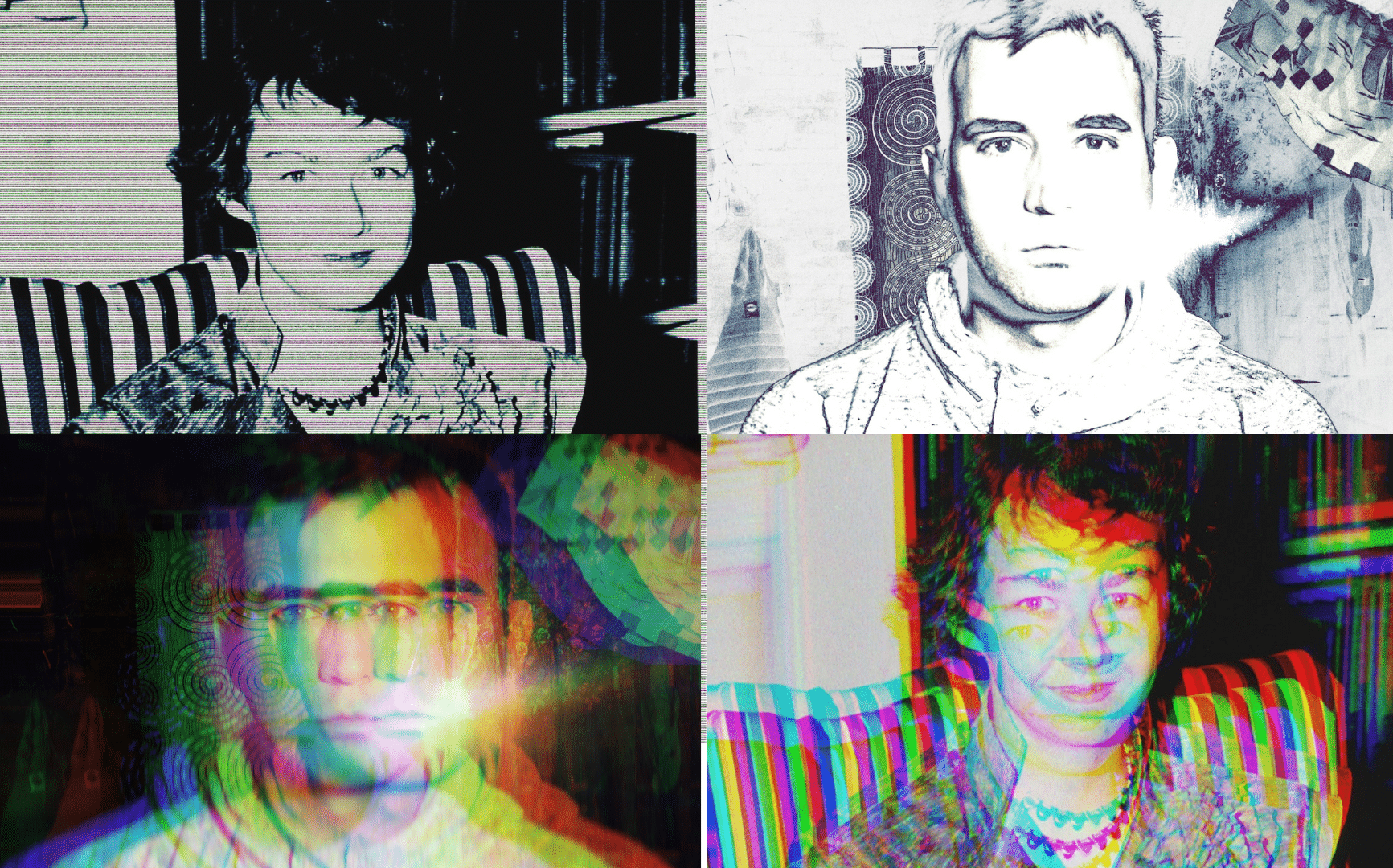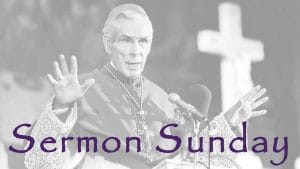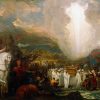-
play_arrow
CRUSADE Channel Previews CRUSADE Preview-Call 844-527-8723 To Subscribe

Christopher Laurence Examines- Seven Swans, Forty Peacocks & the Operation of Grace
“To be alone with me,
to be alone with me,
you went up on a tree.
I’ve never known a man who loved me.”
Beauty is an aspect of the divine. And reflections of beauty in human works are one way the divine shines through humanity. Music is one of the great conveyors of pure beauty, as the Church has known from nearly the beginning. It is no coincidence that music plays a part in the Mass, that monks recite the chants instituted by Saint Gregory the Great to pray and become closer to God. It is all the more harrowing and lamentable then, that so much of the music permeating the popular culture is at best base and unremarkable, and at worst, grotesque and outright diabolical. You will find many more exhortations to promiscuous sex, greed, gross materialism and abasement in all forms than you will any sort of honest exploration or acknowledgment of the truly good and beautiful (never mind the proper exalting of God.)
This makes a little-known album called “Seven Swans” that much more of an outlier. Composed and recorded by the artist Sufjan Stevens, the album is comprised primarily of beautiful descriptions of moments touched by grace, and metaphoric depictions of aspects of the divine.
The album begins with the track “All the Trees of the Field Will Clap their Hands”, a title lifted directly from Scripture. (“For ye shall go out with joy, and be led forth with peace: the mountains and the hills shall break forth before you into singing, and all the trees of the field shall clap their hands.” -Isaiah 55:12) The track expresses the narrator’s desire to unite his will with that of the Lord, singing;
“…I am joining all my thoughts to you
And I’m preparing every part for you,”
It continues with a moment of doubt about whether the narrator will be invited to join the merrymakers who are creating a joyful noise, rejoicing in the Lord, and concludes with a resignation to abandon his own plans and follow after the Will of God;
“And I am throwing all my thoughts away
And I’m destroying every bet I’ve made
And I am joining all my thoughts to you
And I’m preparing every part for you,”
Already, in hearing what is only the first song, we are struck with a sort of spiritual curiosity- an inkling that we may be headed into a listening experience which, -rare indeed these days- may actually be spiritually gratifying. And we would be correct. Skipping ahead we come to a track with Apocalyptic (as in the book of the Apocalypse) imagery, but even more interesting than that is the album’s first clear reference to Sufjan Stevens’ other great inspiration when composing it; the brilliant and staunchly Catholic writer Flannery O’Connor. The title of the track, “In the Devil’s Territory”, is a paraphrasing of a quote by O’Connor describing the nature of her writing;
“My subject in fiction is the action of grace in territory largely held by the Devil,”
For those unfamiliar with O’Connor, let me assure you no description of her work could have been more apt. O’Connor wrote largely about those she often described as “freaks” and “misfits”, who frequently found themselves being (unwittingly and begrudgingly) operated on by grace. Their unconscious response to the offer of this grace -whether to cooperate with it or reject it- would inform what course the story would take, and with what fate they would ultimately meet. This same choice is evident in much of the songwriting on Steven’s album and, propitiously, his protagonist’s answer is most often, “yes”. There is assent to God’s will and an aching desire to draw close to Him most especially and beautifully evident in the song “To Be Alone with You”. The song begins with the narrator confessing what he’d be willing to do so that he might be re-united with… someone;
“I’d swim across Lake Michigan
I’d sell my shoes
I’d give my body to be back again
In the rest of the room
To be alone with you”
We could be forgiven for believing this is just another lament over a lost lover of the type so frequently extolled in pop music; but we would be wrong. This is no simple longing for an earthly love, but an expression of the soul’s desire to be united with God, echoing that famous line of Saint Augustine’s, “Our hearts are restless, O Lord, until they rest in Thee.” The verse which follows makes clear to whom Stevens is referring in his longing;
“You gave your body to the lonely
They took your clothes
You gave up a wife and a family
You gave your ghost
To be alone with me
To be alone with me
To be alone with me
You went up on a tree”
For anyone remotely familiar with the imagery of the Passion there is no mistaking who this is referring to. No earthly lover, but He who loves perfectly and without ceasing. He who humbled Himself and gave up all for love of us, so often unrequited. The love which inspires Stevens to end the song with the line;
“I’ve never known a man who loved me.”
This is an utterly simple, yet terribly deep expression of understanding that the love of no creature holds a candle to the love God possesses for every single soul He has deigned to create. The following track on the album, “Abraham”, is a brief musical retelling of the Biblical story of the binding of Isaac. No metaphors here, but rather a straightforward recounting of another powerful example of man’s resignation to the will of God, and God’s reciprocal outpouring of grace.
A few tracks later we come to “A Good Man is Hard to Find”, a re-presenting of Flannery O’Connor’s famous short story of the same name, this time from the perspective of the murderous Misfit. Unequivocally demonstrating that O’Connor’s (manifestly Catholic) work was a major influence on Stevens when composing this album.
——————————————————————————
Flannery O’Connor raised peacocks. Eventually ending up with a bevy of forty of the birds taking charge of her property. But, all of that began with one chicken.
“This chicken, a buff Cochin Bantam,” Flannery describes in her essay, ‘Living with a Peacock’ “had the distinction of being able to walk either forward or backward. Her fame has spread through the press and by the time she reached the attention of Pathé News,” which sent a photographer to Flannery’s home to photograph the bird, “I suppose there was nowhere left for her to go—forward or backward. Shortly after that she died, as now seems fitting.”
Not long after, O’Connor’s Milledgville, Georgia farm, Andalusia, saw the arrival of a family of peacocks. Though up to that point Flannery had “a pen of pheasants and a pen of quail, a flock of turkeys, seventeen geese, a tribe of mallard ducks, three Japanese silky bantams, two Polish Crested ones, and several chickens of a cross between these last and the Rhode Island Red,” she still “felt a lack.” That lack, it turned out, would be filled by peafowl. O’Connor bought six of the birds from an ad in the Market Bulletin paper, and they arrived by rail from Florida. Before long -and fortified by a steady diet of the farm’s flowers, much to the chagrin of Flannery’s mother- the family of six grew to a flock of forty.
Look to early Christian artwork, especially of Greek origin and influence, and you’ll often find figures of peacocks amid the saints and martyrs. King Solomon was known to have peacocks brought back from far off lands by his sailing ships, along with other exotic items, as testament to his wealth and grandeur. The body of the peacock was thought to be incorruptible after death. St. Augustine put this notion to the test and reported his surprising (though perhaps less-than-miraculous) findings in City of God:
“a year later, it was still the same, except that it was a little more shriveled, and drier.”
The pattern on the peacock’s tail feathers is said to have brought to the mind of early Christians the all-seeing eye of God, and the peacock raising high its spectacular tail, fanning it out to display its previously hidden full radiance and wonder, was thought a rather apt symbol of the Transfiguration of Christ.
There is no evidence that O’Connor was aware of any of this when she settled on buying her family of peafowl, or that she thought about it with any depth at all beyond becoming fascinated by the creatures and seeing the ad in that newspaper. However, there very well may have been a bit of providence at work here, since the peacock is a fine symbol of the work Flannery would go on to create.
Flannery O’Connor was something of an oddity herself; simultaneously a devout Catholic and a deep Southerner. The South that O’Connor inhabited was hardly overrun with Catholics, in fact it was mostly overrun with Evangelicals. Strong believers whose theological beliefs (a term they would almost certainly never use) differed from O’Connor’s, but which at least paralleled hers by operating upon a deep faith in Christ, As Flannery at one point quipped:
“While the South is hardly Christ-centered, it is most certainly Christ-haunted.”
Christ, and O’Connor’s deeply-held, Thomistic-influenced faith, were the bedrock of her writing, and infused all of it; from her novels, to her short fiction, and even (and most explicitly) her personal letters. But the Catholic nature and themes were almost always an undercurrent, a subversive and surprising aspect of her writings. The plots, the settings, the themes and the characters were almost always, on the surface, molded into very Evangelical, Southern, and frequently simple shapes. This was one part due to the surroundings Flannery knew and inhabited, and one part the genius of her method of evangelization through literature, though it’s likely she would not have admitted such a thing outright, at least not in public. Doing so might strip away the illusion, and therefore rob it of some or much or its power. No, Flannery’s methodology was to write stories of ordinary people, “good country people”, as she entitled one of them, in largely ordinary circumstances, and insert an instance of grace in their lives. The operation of grace on her characters, and their choice, often unwitting, to accept it or reject it, determined their fate, or the changing or stagnation of their outlook. This often snuck up on them, and on the reader, and the consequences of the acceptance or rejection could be subtle, outlandish, or left up to the audience to imagine. As Flannery once said,
“All my stories are about the action of grace on a character who is not very willing to support it, but most people think of these stories as hard, hopeless and brutal.”
So, in many ways, O’Connor’s works mirrored the peacock; frequently unremarkable, unassuming, not standing apart from its surroundings in a particular way. You might miss it on a farm amidst all other manner of fowl and barnyard animals. Yet, when something operates upon it, and inclines it to raise and spread its tail, everything is changed, transfigured- and it is as if the thing has adopted an entirely new nature.
Good art, good literature, good fiction, can all work the same way. If the Holy Ghost is allowed to operate on and be cooperated with through the writer, the painter, the musician, their work can become transcendent, transformational. It can lift the mind and soul to God. The pinnacles of musical achievement in these regards is Gregorian Chant, then classical music. But popular music can effect these changes as well, in rare instances, when it is properly ordered; truly reaching to and speaking of the things of God.
Scripture is the inspired Word of God. It is the zenith of the written word which leads to salvation. But a good story, a good novel, can elevate the spirit, also. It can be the first step for one’s journey, or the step-stool by which one clambers over a stumbling block. God created the world and saw that it was Good. Let us also create, and search out in other’s creations, that which He may deem good, and which will lead us, (through beauty; through truth; through a captive and subjugated imagination) to Him.
Our Readers And Listeners Keep Us In Print & On The Air!
Click here to subscribe to The CRUSADE Channel’s Founders Pass Member Service & Gain 24/7 Access to Our Premium, New Talk Radio Service. www.crusadechannel.com/go
What Is The Crusade Channel?
The CRUSADE Channel, The Last LIVE! Radio Station Standing begins our LIVE programming with our all original CRUSADE Channel News hosted by Ron Staffard. Coupled with Mike “The King Dude” Church entertaining you during your morning drive and Rick Barrett giving you the news of the day and the narrative that will follow during your lunch break!
We’ve interviewed over 300 guests, seen Brother Andre Marie notch his 200th broadcast of Reconquest; The Mike Church Show over 1200 episodes; launched an original LIVE! News Service; written and produced 4 Feature Length original dramas including The Last Confession of Sherlock Holmes and set sail on the coolest radio product ever, the 5 Minute Mysteries series! We were the ONLY RADIO outlet to cover the Impeachment Trials of President Trump from gavel to gavel!
Now that you have discovered The Crusade, get30 days for FREE of our premium News-Talk Radio service just head to:
https://crusadechannel.com OR download our FREE app: https://apps.appmachine.com/theveritasradionetworkappIti-
Did you know about Forty Peacocks? If you are interested in supporting small business, be sure to check out the official store of the Crusade Channel, the Founders Tradin Post! Not to mention our amazing collection of DVD’s, Cigars, T-Shirts, bumper stickers and other unique selection of items selected by Mike Church!
Written by: Christopher L
Similar posts
SEARCH
ON AIR

Sermon Sundays
We Don't Work On Sundays
Sermons culled from traditional Catholic priests according to the season.
close-
Recent Posts
RECENT PODCASTS
TRENDING
Copyright BlackHat Studios 2024 dba The CRUSADE Channel, All Rights Reserved












Post comments (0)